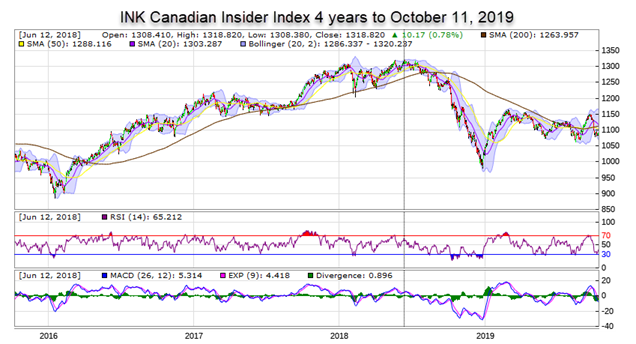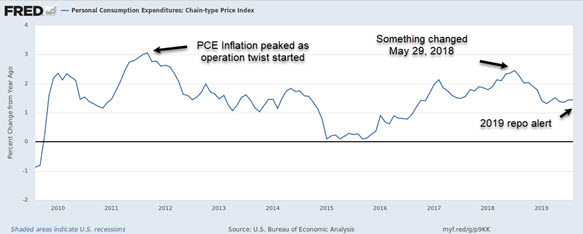BB1: The Fed just gave commodities the biggest boost since 2011
Economy-sensitive stocks received some good news out of Washington on Friday, and it had nothing to do with the trade war. For industrial commodities, it could be the biggest news in over 8 years.
IMF global commodity prices peaked in the second quarter of 2011 coinciding with the end of QE 2 which involved the Fed buying approximately $75 billion worth of Treasury bonds and notes over an 8-month period. Commodities began their multi-year slide, thanks in no small part to Fed intervention with operation twist (OT) which it started in the fall of the same year. Unlike QE, OT focused on flattening the yield curve by putting a floor on short-term rates by selling Treasury bills and buying longer-term securities. As we wrote at the time, there would be no twisting by the pool for commodities investors as this policy was unequivocally bad for commodity prices. Essentially, OT provided commodities with a headwind by putting a floor on their carrying costs which can be approximated by the one-year real US dollar interest rate.
Bernanke brought in OT to help cool inflation as the Fed's preferred price index the PCE has poking towards 3%. Unfortunately for the Fed, OT was so effective in fighting inflation that it set the PCE on a downward path until it nearly hit zero in 2015. It has been range-bound ever since and has never seriously been poised to reach the Fed's 2% target on a sustainable basis.
Ever since, the Fed has paid lip service to its inflation target, blaming transitory forces. However, that excuse started to wear thin last year as inflation expectations started heading south mid last year. In fact, in his October 7th Real Vision interview available on INK Ultra Money, Tom Snider from Alhambra Investment Partners made the case that a deflationary turning point occurred on May 29th of last year. The Snider interview is one of the most popular videos on Real Vision right now and there is a free overview version of it available:
Free: Snider on dangers beneath the repo surface.
Snider believes something happened in the credit markets which is still unexplained, but whatever it was, it was not good. Globally-economically sensitive equities subsequently started to roll over as can be seen in the INK Canadian Insider Index which peaked in June of last year.
 The INK CIN Index peaked in June 2018 (click for larger)
The INK CIN Index peaked in June 2018 (click for larger)
Nevertheless, collapsing inflation expectations and stumbling economy-sensitive stocks were not enough to get the Fed worried. Instead, as late as December of last year they were still talking about multiple rate hikes this year!
The Fed's tune started to change early in the New Year after stocks collapsed in December. Given the Fed's reaction function to stock prices, it is obvious they care more about the price level of the S&P 500 than they do about the PCE Index. As much as they want to please Wall Street by keeping US large-cap stocks inflated, they are even more concerned about the behaviour of interest rates. After all, that is their job to set interest rate policy.
So, when the Fed Funds rate blew out to as high as 10% last month, that also got their attention. They immediately rolled out overnight repurchase agreements (repos) which were designed to inject about $75 billion of liquidity into the system. That was supported by about $70 billion in weekly term repos.
On Friday the Fed went one big step further by announcing it was going to buy $60 billion worth of Treasury bills a month until at least the second quarter of next year. Let's call it bill buying one (BB1). That is almost the equivalent of QE 2, and if it keeps going, it will even be bigger. As Sven Henrich noted over the weekend, on an annualized basis that is the equivalent of the entire US defence budget.
We believe the analogy is appropriate. Despite the Fed's claims that its bill purchases are focused on reserve management, it is now essentially helping the US government fund its operations. Call it a happy unintended consequence for Uncle Sam.
It could also have a positive unintended consequence for the INK CIN Index and other economy-sensitive benchmarks which should benefit as monetary policy shifts in favour of steepening the yield curve. At this point, the timing of the positive boost to the INK CIN and other cyclical-oriented benchmarks is uncertain. Before BB1 was announced, Michael Kantrowitz appeared on Real Vision to make the case that cyclical stocks should make a turn for the better early next year, but things could get worse before they get better. We will have to see if the Fed's BB1 bazooka is enough to speed things up and spark a rally in cyclicals before year-end.
Kantrowitz: better times ahead for cyclical stocks
Commodity investors, in particular, have reason to smile now. By purchasing Treasury bills, the Fed is helping to put a ceiling on short-term rates, which should help to put a ceiling on the carrying costs of storing commodities. This is exactly the opposite of what happened under OT.
While commodity prices are driven by more than just carrying costs, the Fed's BB1 is a big helping hand. It should even help the oil & gas group once they get past their seasonally weak fall period. In the short term, we expect the gold-silver to grind lower in favour of silver. As such, we will be keeping a close eye on silver and polymetallic mining stocks in the weeks ahead to see which ones move up our rankings. Right now, there are very few that make it into our top 30%. But BB1 has just started.
This post is a version of an article that first appeared on INKResearch.com.
 Click for larger
Click for larger